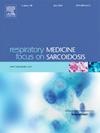肺间质性疾病患者肺康复后股四头肌最大自主收缩的最小临床重要差异
IF 3.1
3区 医学
Q2 CARDIAC & CARDIOVASCULAR SYSTEMS
引用次数: 0
摘要
背景:骨骼肌损失对间质性肺疾病(ILD)患者的日常生活具有破坏性影响。肺康复(PR)改善肌力;然而,缺乏临界值来定义临床改善限制了获得的收益的可解释性。目的:通过手持式测力仪评估ILD患者PR后四头肌最大自主收缩(QMVC)的最小临床重要差异(MCID),以千克力(KgF)的绝对值和预测值的百分比(% pred)。方法:对先前三项研究的资料进行二次分析。参与者参加了为期12周的社区公关计划。使用基于锚点和分布的方法计算mcid。锚点包括1分钟坐立(1分钟STS)测试、6分钟步行距离、握力、修正医学研究委员会问卷、圣乔治呼吸问卷和慢性疾病治疗-疲劳功能评估量表。合并后的MCIDs采用加权算术平均值(2/3锚定法和1/3分布法)计算。结果:59例ILD患者(61%为女性,66±11岁)纳入分析。1分钟STS测试是唯一符合标准的锚点。PR后QMVC有显著改善(平均差值=3.9±8.2 KgF,中位差值=10.9 [1.6;22.0]% pred, p)。结论:PR后ILD患者QMVC至少增加3.2 KgF或10.6% pred代表临床相关改善。本文章由计算机程序翻译,如有差异,请以英文原文为准。
Minimal clinically important difference for quadriceps maximal voluntary contraction following pulmonary rehabilitation in people with interstitial lung disease
Background
Skeletal muscle loss has a devastating effect on daily lives of people with interstitial lung disease (ILD). Pulmonary rehabilitation (PR) improves muscle strength; however, the lack of cut-off values to define clinical improvement limits the interpretability of the obtained gains.
Objective
To estimate the minimal clinically important difference (MCID) for quadriceps maximal voluntary contraction (QMVC) in people with ILD, assessed with hand-held dynamometry as an absolute value in kilogram-force (KgF) and as percentage of the predicted value (% pred), after PR in people with ILD.
Methods
A secondary analysis of data from three previous studies was conducted. Participants took part in a 12-week community-based PR programme. The MCIDs were computed using anchor- and distribution-based methods. Anchors explored were the 1-min sit-to-stand (1-min STS) test, the 6-min walking distance, handgrip strength, modified Medical Research Council questionnaire, St. George's Respiratory Questionnaire and Functional Assessment of Chronic Illness Therapy-Fatigue Subscale. The pooled MCIDs were computed using the weighted arithmetic mean (2/3 anchor and 1/3 distribution-based methods).
Results
Fifty-nine people with ILD (61 % female, 66 ± 11years) were included in the analysis. The 1-min STS test was the only anchor fitting the criteria. There were significant improvements after PR in the QMVC (mean difference = 3.9 ± 8.2 KgF and median difference = 10.9 [1.6; 22.0] % pred, p < 0.001) and 1-min STS test (mean difference = 6.6 ± 7.1 repetitions, p < 0.001). The pooled MCIDs were 3.2 KgF and 10.6 % pred.
Conclusion
An increase of at least 3.2 KgF or 10.6 % pred for QMVC in people with ILD after PR represents clinically relevant improvements.
求助全文
通过发布文献求助,成功后即可免费获取论文全文。
去求助
来源期刊

Respiratory medicine
医学-呼吸系统
CiteScore
7.50
自引率
0.00%
发文量
199
审稿时长
38 days
期刊介绍:
Respiratory Medicine is an internationally-renowned journal devoted to the rapid publication of clinically-relevant respiratory medicine research. It combines cutting-edge original research with state-of-the-art reviews dealing with all aspects of respiratory diseases and therapeutic interventions. Topics include adult and paediatric medicine, epidemiology, immunology and cell biology, physiology, occupational disorders, and the role of allergens and pollutants.
Respiratory Medicine is increasingly the journal of choice for publication of phased trial work, commenting on effectiveness, dosage and methods of action.
 求助内容:
求助内容: 应助结果提醒方式:
应助结果提醒方式:


